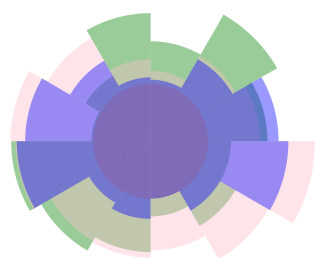The morphological study of open clusters can provide observational evidence for tracing the formation mechanism of star clusters and help to explore the evolution of star clusters. The morphology of open clusters on the two-dimensional projection planes mostly conforms to the core-shell structure, and whether this layered structure actually exists in three-dimensional(3D)space is inconclusive.
Recently, researchers from the Xinjiang Astronomical Observatory (XAO) of the Chinese Academy of Sciences proposed a rose diagram overlaying method based on Gaia data to study the three-dimensional layered structure of open cluster samples within 500pc near the sun.
The results showed that the rose diagram overlaying method can quantitatively depict the morphology of open star clusters and provide method support for identifying the three-dimensional structure of open cluster samples. The method may play an important role in the structural classification of open clusters .
The results were published in Astronomy and Astrophysics (A&A).
The researchers used the rose diagrams to quantitatively depict the random morphology of open clusters on three projection surfaces in 3D space (Figure 1). The synthetic rose diagram of each open cluster sample was obtained by overlay (Figure 2), and whether the composite diagram has a stable core circle was used as an indicator to identify whether the open cluster sample has a three-dimensional layered structure.
The study results indicated that if a stable inner circle appears in the superimposed rose diagram of a cluster, then the open cluster has a three-dimensional layered structure. In addition, the researchers defined the basic parameters of the three-dimensional layered structure, including circle core area and irregular nuclear region, the unstable kernel area, and the unstable parameters of the layered structure.
Through statistical analysis, they also found that the circle core area of the open cluster sample maintains a relatively significant positive correlation with the number of its own member stars, while there was a significant negative correlation between the irregular nuclear region of the layered structure of the open cluster sample and the number of its own member stars.
This study is the first time to explore the three-dimensional layered structure of open star clusters using the rose diagram overlaying method. The physical mechanism behind the three-dimensional layered structure of star clusters and the conditions for forming the three-dimensional layered structure of star clusters still need to be further studied.

Figure 1. (a) Before corrected distance (gray scatter) and after corrected distance (colored scatter), the distribution of member stars of the Gulliver 20 Cluster sample on three projection planes. (b) Rose diagrams of the open cluster sample(Gulliver 20 cluster) on three projection planes after correction distance.

Figure 2. Overlaying rose diagram of the Gulliver 20 star cluster. The dark purple circular region represents the cluster's regular core, and the dark blue region represents its irregular core. The remaining color regions are the outer structure of the cluster.
Contact: HU Qingshun; ZHANG Yu
Xinjiang Astronomical Observatory, Chinese Academy of Sciences
Email: zhy@xao.ac.cn
Paper link: https://doi.org/10.1051/0004-6361/202244199